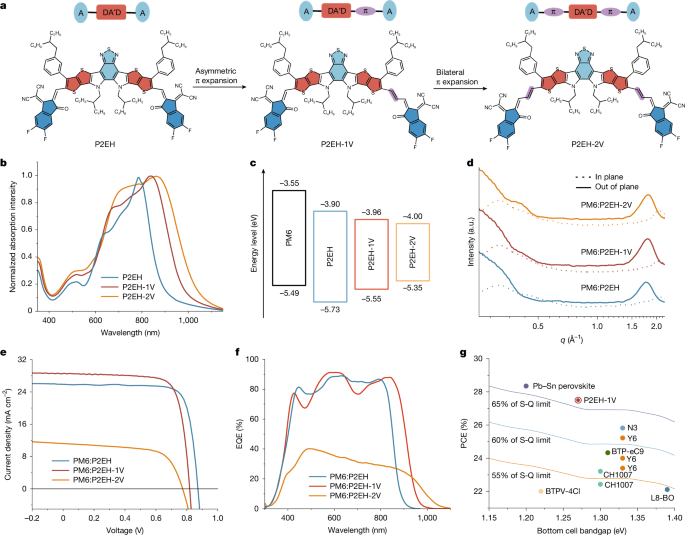Brinkmann, K. O. et al. Perovskite–organic tandem solar cells. Nat. Rev. Mater. 9, 202–217 (2024).
Brinkmann, K. O. et al. Perovskite–organic tandem solar cells with indium oxide interconnect. Nature 604, 280–286 (2022).
Chen, W. et al. Monolithic perovskite/organic tandem solar cells with 23.6% efficiency enabled by reduced voltage losses and optimized interconnecting layer. Nat. Energy 7, 229–237 (2022).
Lin, Y. et al. An electron acceptor challenging fullerenes for efficient polymer solar cells. Adv. Mater. 27, 1170–1174 (2015).
Meng, L. et al. Organic and solution-processed tandem solar cells with 17.3% efficiency. Science 361, 1094–1098 (2018).
Chen, W. et al. A semitransparent inorganic perovskite film for overcoming ultraviolet light instability of organic solar cells and achieving 14.03% efficiency. Adv. Mater. 30, 1800855 (2018).
Zhang, Z. et al. Suppression of phase segregation in wide-bandgap perovskites with thiocyanate ions for perovskite/organic tandems with 25.06% efficiency. Nat. Energy 9, 592–601 (2024).
Chen, X. et al. Efficient and reproducible monolithic perovskite/organic tandem solar cells with low-loss interconnecting layers. Joule 4, 1594–1606 (2020).
Wang, X. et al. Highly efficient perovskite/organic tandem solar cells enabled by mixed-cation surface modulation. Adv. Mater. 35, 2305946 (2023).
Ho-Baillie, A. W. Y. et al. Recent progress and future prospects of perovskite tandem solar cells. Appl. Phys. Rev. 8, 041307 (2021).
Jiang, X. et al. Isomeric diammonium passivation for perovskite–organic tandem solar cells. Nature 635, 860–866 (2024).
Chen, H. et al. Improved charge extraction in inverted perovskite solar cells with dual-site-binding ligands. Science 384, 189–193 (2024).
Wang, Y. et al. Homogenized contact in all-perovskite tandems using tailored 2D perovskite. Nature 635, 867–873 (2024).
Jost, M. et al. Perovskite/CIGS tandem solar cells: from certified 24.2% toward 30% and beyond. ACS Energy Lett. 7, 1298–1307 (2022).
He, Z. et al. Minimized optical/electrical energy loss for 25.1% monolithic perovskite/organic tandem solar cells. Nat. Commun. 16, 1773 (2025).
Wu, S., Liu, M. & Jen, A. K. Y. Prospects and challenges for perovskite–organic tandem solar cells. Joule 7, 484–502 (2023).
Yuan, J. et al. Single-junction organic solar cell with over 15% efficiency using fused-ring acceptor with electron-deficient core. Joule 3, 1140–1151 (2019).
Leijtens, T. et al. Opportunities and challenges for tandem solar cells using metal halide perovskite semiconductors. Nat. Energy 3, 828–838 (2018).
Wang, J. et al. The principles, design and applications of fused-ring electron acceptors. Nat. Rev. Chem. 6, 614–634 (2022).
Cheng, P. & Yang, Y. Narrowing the band gap: the key to high-performance organic photovoltaics. Acc. Chem. Res. 53, 1218–1228 (2020).
Liu, W. et al. Design of near-infrared nonfullerene acceptor with ultralow nonradiative voltage loss for high-performance semitransparent ternary organic solar cells. Angew. Chem. Int. Ed. 61, e202116111 (2022).
Jia, Z. et al. High performance tandem organic solar cells via a strongly infrared-absorbing narrow bandgap acceptor. Nat. Commun. 12, 178 (2021).
Chen, Z. et al. Ultrafast energy transfer from polymer donors facilitating spectral uniform photocurrent generation and low energy loss in high-efficiency nonfullerene organic solar cells. Energy Environ. Sci. 16, 3373–3380 (2023).
Sun, C. et al. Achieving fast charge separation and low nonradiative recombination loss by rational fluorination for high-efficiency polymer solar cells. Adv. Mater. 31, 1905480 (2019).
Liu, Y. et al. Recent progress in organic solar cells (Part I material science). Sci. China Chem. 65, 224–268 (2022).
Yi, J. et al. Advantages, challenges and molecular design of different material types used in organic solar cells. Nat. Rev. Mater. 9, 46–62 (2024).
Jia, Z. et al. Near-infrared absorbing acceptor with suppressed triplet exciton generation enabling high performance tandem organic solar cells. Nat. Commun. 14, 1236 (2023).
Qin, S. et al. Constructing monolithic perovskite/organic tandem solar cell with efficiency of 22.0% via reduced open-circuit voltage loss and broadened absorption spectra. Adv. Mater. 34, 2108829 (2022).
Zhang, J. et al. Alkyl-chain branching of non-fullerene acceptors flanking conjugated side groups toward highly efficient organic solar cells. Adv. Energy Mater. 11, 2102596 (2021).
Kong, X. et al. 18.55% efficiency polymer solar cells based on a small molecule acceptor with alkylthienyl outer side chains and a low-cost polymer donor PTQ10. CCS Chem. 5, 841–850 (2023).
Hai, J. et al. Achieving ultra-narrow bandgap non-halogenated non-fullerene acceptors via vinylene π-bridges for efficient organic solar cells. Mater. Adv. 2, 2132–2140 (2021).
Li, X. et al. Synthesis and photovoltaic properties of a series of narrow bandgap organic semiconductor acceptors with their absorption edge reaching 900 nm. Chem. Mater. 29, 10130–10138 (2017).
Liu, W. et al. Low-bandgap non-fullerene acceptors enabling high-performance organic solar cells. ACS Energy Lett. 6, 598–608 (2021).
Shi, W. & Ma, H. Spectroscopic probes with changeable π-conjugated systems. Chem. Commun. 48, 8732–8744 (2012).
Bertrandie, J. et al. The energy level conundrum of organic semiconductors in solar cells. Adv. Mater. 34, 2202575 (2022).
Zhu, L. et al. Achieving 20.8% organic solar cells via additive-assisted layer-by-layer fabrication with bulk pin structure and improved optical management. Joule 8, 3153–3168 (2024).
Li, S. et al. Highly efficient fullerene-free organic solar cells operate at near zero highest occupied molecular orbital offsets. J. Am. Chem. Soc. 141, 3073–3082 (2019).
Xie, Y. et al. Assessing the energy offset at the electron donor/acceptor interface in organic solar cells through radiative efficiency measurements. Energy Environ. Sci. 12, 3556–3566 (2019).
Xu, Y. et al. Tuning the hybridization of local exciton and charge-transfer states in highly efficient organic photovoltaic cells. Angew. Chem. Int. Ed. 59, 9004–9010 (2020).
Classen, A. et al. The role of exciton lifetime for charge generation in organic solar cells at negligible energy-level offsets. Nat. Energy 5, 711–719 (2020).
Yi, Z. et al. Achieving a high open-circuit voltage of 1.339 V in 1.77 eV wide-bandgap perovskite solar cells via self-assembled monolayers. Energy Environ. Sci. 17, 202–209 (2024).
Wang, X. et al. Regulating phase homogeneity by self-assembled molecules for enhanced efficiency and stability of inverted perovskite solar cells. Nat. Photon. 18, 1269–1275 (2024).
Siekmann, J. et al. Characterizing the influence of charge extraction layers on the performance of triple-cation perovskite solar cells. Adv. Energy Mater. 13, 2300448 (2023).


